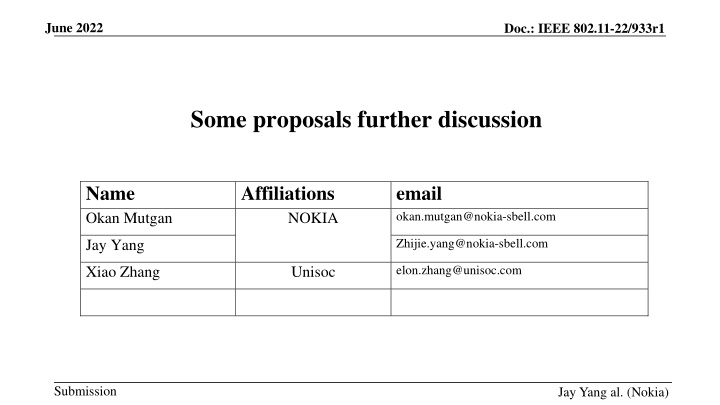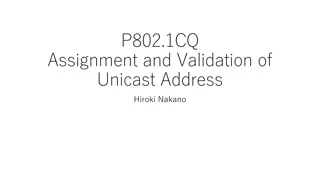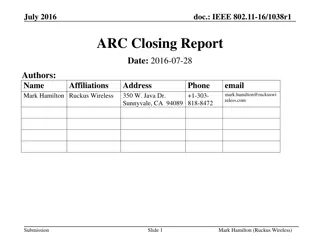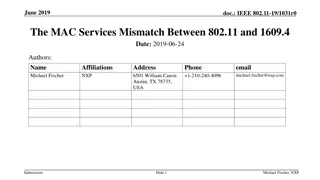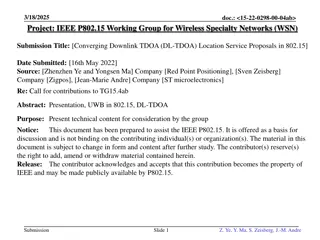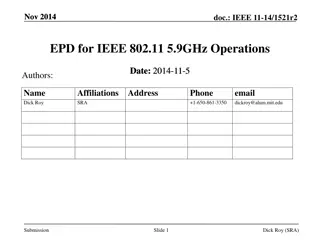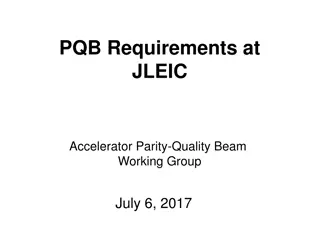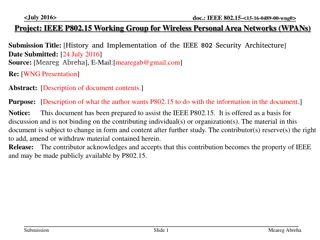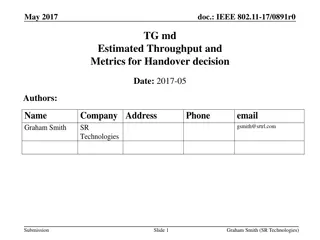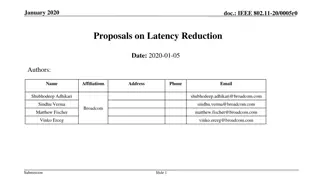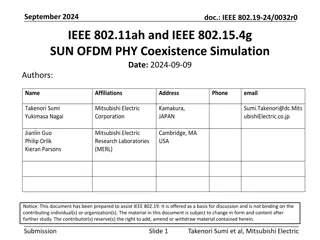IEEE 802.11-22/933r1 Proposals for Further Discussion
This document discusses proposals presented in the IEEE 802.11-22/933r1 meeting regarding addressing specific use cases within the group. Various solutions such as RRCM, MAAD, IRMA, and others are considered to support use cases 4.1, 4.2, 4.8, and 4.26. Additionally, it highlights the motivation to progress and achieve consensus on solutions before the upcoming plenary meeting.
Download Presentation

Please find below an Image/Link to download the presentation.
The content on the website is provided AS IS for your information and personal use only. It may not be sold, licensed, or shared on other websites without obtaining consent from the author.If you encounter any issues during the download, it is possible that the publisher has removed the file from their server.
You are allowed to download the files provided on this website for personal or commercial use, subject to the condition that they are used lawfully. All files are the property of their respective owners.
The content on the website is provided AS IS for your information and personal use only. It may not be sold, licensed, or shared on other websites without obtaining consent from the author.
E N D
Presentation Transcript
June 2022 Doc.: IEEE 802.11-22/933r1 Some proposals further discussion Name Okan Mutgan Affiliations NOKIA email okan.mutgan@nokia-sbell.com Jay Yang Zhijie.yang@nokia-sbell.com Xiao Zhang Unisoc elon.zhang@unisoc.com Submission Jay Yang al. (Nokia)
June 2022 Doc.: IEEE 802.11-22/933r1 Background-1 In 332r37, 11bh group agrees to have a solution to address use case 4.1,4.2.4.8 and 4.26. Not complete at present. Straw Poll 1: Given that multiple schemes can be easily be accommodated, should TGbh include more than one scheme in the Draft such that, for example, pre-association use cases may be addressed? Y: 17/ N: 3/A: 2 Not complete at present. 11bh group plan to deliver draft1.0, which means all features design is completed. 11bh group has to defer its schedule again if it can t complete the task. Submission Jay Yang al. (Nokia)
June 2022 Doc.: IEEE 802.11-22/933r1 Motivation To make some progress and move forward, 11bh group should support at least one solution to address the use case 4.1,4.2, 4.8 and 4.26 before/in the following plenary meeting. Candidate proposals list: (1) RRCM (Okan) (2) MAAD (Graham) (3) IRMA (Graham) (4) Other possible solutions Submission Jay Yang al. (Nokia)
June 2022 Doc.: IEEE 802.11-22/933r1 WPA3_specification 9.1.3 Active Scanning Procedures When performing active scanning procedures, the STA shall construct a randomized MAC address following the requirements defined in in Section 12.2.10 of [1], for transmission of Probe Request frames. The STA shall use a randomized MAC address for scanning while the STA is not associated to a BSS. The STA shall construct a new randomized MAC address for each active scanning instance. 9.1.4 ANQP Procedures For each ANQP exchange, a STA shall use a new randomized MAC address following the requirements defined in Section 12.2.10 of [1], while the STA is not associated to a BSS Submission Slide 4 Jay Yang al. (Nokia)
June 2022 Doc.: IEEE 802.11-22/933r1 TGbh PAR Scope (emphasis added) This amendment specifies modifications to the medium access control (MAC) mechanisms to preserve the existing services that might otherwise be restricted in environments where STAs in an ESS use randomized or changing MAC addresses, without affecting user privacy. User privacy includes exposure of trackable information to third parties or exposure of an individual's presence or behavior. This amendment introduces mechanisms to enable session continuity in the absence of unique MAC address-to-STA mapping. For STAs in an ESS that use randomized or changing MAC addresses, this amendment preserves the ability to provide customer support, conduct network diagnostics and troubleshooting, and detect device arrival in a trusted environment. There is a need to: Ensure that IEEE Std 802.11 provisions that refer to a STA MAC address remain valid when that MAC address is random or changes. Design mechanisms that enable an optimal user experience when the MAC address of a STA in an ESS is randomized or changes. These mechanisms should not decrease user privacy. Submission Slide 5 Jay Yang al. (Nokia)
June 2022 Doc.: IEEE 802.11-22/933r1 Comparison among the proposals-1 RRCM Different RMAs for different mgmt. frames. RMA1 probe RMA2 ANQP RMA3 authentication Similar to use case 4.1 MAAD Same RMAs for different mgmt. frames. RMA1 probe RMA1 ANQP RMA1 authentication Similar to use case 4.1 IRMA Same RMAs for different mgmt. frames. RMA1 probe, RMA1 ANQP RMA1 authentication Similar to use case 4.1 Use case 4.1(pre- association client steering) Use Case4.2(access control) Use case 4.8(post- association client steering) Different RMAs for different probes. RMA1 for probe1. RMA2 for probe2. Similar to use case 4.8 Same RMAs for different probes. RMA1 probe(s) Same RMAs for different probes. RMA1 probe(s) Use case 4.26(VBSS) Similar to use case 4.8 Similar to use case 4.8 Submission Slide 6 Jay Yang al. (Nokia)
June 2022 Doc.: IEEE 802.11-22/933r1 Comparison among the proposals-2 RRCM Low Overhead, STA may not generate RMA(s) in each association. No (RMA relies on PTK) MAAD High overhead, AP has to assign a new RMA in each association No (AP assigns RMA) IRMA High overhead, STA has to generate a new RMA in each association Yes (Different STAs may use same RMA) Not Supported (such as use case 4.8 and 4.26) Easy to be tracked. MGMT. frames uses same RMA. Not supported (3rd party can locate the user based on STA s same RMA) No Overhead issue RMA Conflict issue WPA3 specification scope Supported (each probe use different RMAs) Can t be tracked. MGMT. frames use different RMAs. Supported (STAs using several RMA(s), not deceasing user privacy) Yes (key and RMA generation) Not Supported (such as use case 4.8 and 4.26) Easy to be tracked. MGMT. frames uses same RMA. Not supported (3rd party can locate the user based on STA s same RMA) No 3rd party tracking issue based on unprotected MGMT. frame 11bh PAR scope Computational cost Extend to 11bi Possible in the future Not clear Not clear Submission Slide 7 Jay Yang al. (Nokia)
June 2022 Doc.: IEEE 802.11-22/933r1 Computational Cost of old IRMA Example, 1 million STAs information stored in the network. In their first association, STAs generate their keys IRMKs (IRMK1 IRMK-1M), send them to AP. AP maps them and stores them. STA1 <-> IRMK1 . STA-1M <-> IRMK-1M In the subsequent association, - A STA generates its IRMA x and HASH-x and sends HASH-x to AP in association req frame. - When AP wants to identify the STA-x, the procedure is as follows: - Use the stored IRMK-m and IRMA-x to calculate the HASH-m, if HASH-m doesn t match HASH-x, use the next IRMK to repeat. - In the worst case, AP needs to go though the whole DB and calculate 1M times to find the matched HASH value. Therefore, the computational cost relies on the DB length. e.g. n STAs keys stored in the DB, the AP may calculate N times to identify each STA in worst case.(computation NO. =n) HASH1 == HASH(IRMA-x, IRMK1). -> NO HASH2 == HASH(IRMA-x, IRMK2). -> NO HASH-1M == HASH(IRMA-x, IRMK-1M). -> YES Submission Slide 8 Jay Yang al. (Nokia)
June 2022 Doc.: IEEE 802.11-22/933r1 Computational Cost of RRCM Example, 1 million STAs information is stored in the network. (note: each STA generates two RMAs) In their first association, STAs and AP generate their keys (RMAK1, RMAK2, RMAK3) and RMAs (RMA1.1, RM1.2 etc). AP maps RMAs and stores them. STA1 <-> RMA1.1, RMA1.2 STA-1M <-> RMA-1M.1,RMA- 1M.2 In the subsequent association, - STAs uses the generated RMAs. - AP receives RMAs (from STAs SA) and identifies the STA immediately. In this example (1M STAs), to identify one STA , AP computational NO. = 2 (equal to generated no of RMAs). Generally speaking (n STAs), to identify one STA, AP needs m computation for each STA, where m is the number of generated RMAs and m << n. RMA1.1, RMA1.2 => STA1 . RMA-1M.1, RMA-1M.2 => STA-1M Submission Slide 9 Jay Yang al. (Nokia)
June 2022 Doc.: IEEE 802.11-22/933r1 Computational Cost of RRCM & old IRMA Computations needed to identify one STA The reason of high computation in old IRMA is that -> In first association, AP just stores many key values. -> In the subsequent association, AP goes though the whole DB to calculate HASH and compares it one by one. n (NO. of STAs Key in DB) Computation times m (NO. of generated RMAs) m=1 Number of STAs (n) IRMA RRCM (single RMA) RRCM (multiple RMAs) Submission Slide 10 Jay Yang al. (Nokia)
June 2022 Doc.: IEEE 802.11-22/933r1 Reference [1] 802.11bh draft 0.2 [2] 11-22-0924-00-00bh-802-11bh-telecon-minutes-june-21-2022.docx [3] 11-21-0332-37-00bh-issues-tracking.docx [4] WPA3 Specification version 3.0 [5] 11-22-0908-01-00bh-multiple-schemes-for-tgbh.pptx Submission Jay Yang al. (Nokia)
June 2022 Doc.: IEEE 802.11-22/933r1 SP1 In order to move forward and make some progress, do you agree Opt(X) should be used as the solution to the use case 4.1, 4.2, 4.8 and 4.26? Opt1: RRCM (Okan) Opt2: MAAD and/or IRMA (Graham) Opt3: Abstain Submission Slide 12 Jay Yang al. (Nokia)
June 2022 Doc.: IEEE 802.11-22/933r1 SP2 Do you agree the proposed text in 11-22/888r2 should be incorporated into TGbh Amendment? Y/N/A Submission Slide 13 Jay Yang al. (Nokia)
June 2022 Doc.: IEEE 802.11-22/933r1 THANK YOU Submission
